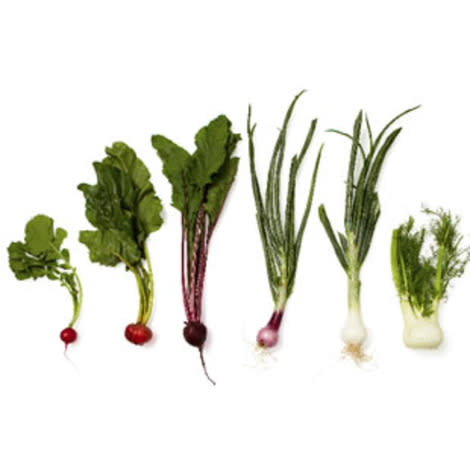8 Edible Items You’re Throwing Away (and 2 to Toss)

By Hilary Meyer, Associate Food Editor, EatingWell Magazine
I like to cook with a lot of vegetables, but the waste can really pile up. I was becoming horrified to see exactly how much trash was leaving my kitchen. So I started a compost bin. I feel better since the compostable stuff is at least going to good use. But now my compost bin is filling up, which led me to think about what I was throwing in there. Is it all compost or can I find another use for it? Here are a few things you can actually keep and eat (and some you should toss).
Don't Miss: 5 Ways to Stop Wasting Food and Start Saving Money
Radish Greens: It's not just the peppery bulb that the radish has to offer. Try eating the greens too! If you find radishes with the greens still attached (or if you grow your own), enjoy their peppery flavor in a salad.
Fennel Fronds: You may have seen fennel fronds here and there and thought it was dill (they look very similar), but the fronds have a licorice flavor that's more mild than the actual fennel bulb they grow on. Use fronds to garnish soup or chop them up and sprinkle them over a seared fish fillet (fennel tastes wonderful with seafood). You can also add them to lettuce mixes for flavor and beauty.
Related: 3 More Fronds You Can Eat
Spring Onion Tops: If you find an onion with the long greens still attached (mostly in spring), don't throw those greens away! They have a lovely mild onion flavor and you can use them just as you would use a scallion. Chop them up and mix them with Neufchâtel cream cheese to spread on a cracker or add them to fresh salsa.
Beet Greens: If you're a fan of beets, you may know this already, but folks who are just warming up to this earthy root vegetable may not realize that beet greens are edible too. (And some may actually prefer them to the root as their flavor tends to be more mild than the beet itself.) The greens are great sautéed with minced garlic and a little olive oil. If the red vein down the center of the leaf is large, you may want to separate it from the leaf, chop it up and start cooking it before you add the greens so it can soften before the greens overcook.
Turnip Greens: If you live in the Southeast, you are probably no stranger to turnip greens. But others (including myself) didn't know you could eat them. They have a strong bitter flavor (similar to mustard greens or broccoli rabe), so you are best off cooking mature leaves until they are good and wilted. Tender baby turnip greens are milder and can be eaten raw in salads or sandwiches.
Dandelion Greens: Yes, the same flowers that pepper the landscape in early summer can be dinner. Or at least part of it. I like to put them in salad. They tend to be bitter, so if you want to tone them down, sauté them with other vegetables. Something to note: Although the dandelions popping up in seemingly every landscape are edible, it's best to stick with dandelion greens that have been cultivated for eating. You never know who or what may have sprayed the flowers growing in your neighbor's yard.
Recipe to Try: 5 Delicious Recipes for Dandelion Greens
Flowers: Not all flowers are edible. (Many are poisonous.) But plenty are, and they look stunning in salad mixes, used as garnish on the plate or blended with water and sugar for syrups. In the case of squash blossoms, you can even use them for stuffing. What are other flowers you can eat? Nasturtiums, fennel flowers, roses, violets and pansies. Look for flowers intended for eating at the grocery store, not the florist--they could be loaded with pesticides.
Don't Miss: 4 Tips for Cooking with Edible Flowers
Chicken and Turkey Bones: After you roast a chicken or turkey, do you throw away the bones? Don't! Use the bones to make stock by boiling them with onion, celery and carrots for about 4 hours, then use the stock in soup or freeze it for later.
Recipes to Try: EatingWell's Homemade Chicken Stock Recipe
Stale bread: Just because it's no longer ideal for sandwiches doesn't mean you should throw your stale bread away. (Note: I said stale, not moldy.) Here are a few ideas for stale bread: Put it in the food processor for fresh breadcrumbs; use it for stuffing or bread pudding; or cut it up, toss with oil and bake in the oven for homemade croutons.
Here are two items that you SHOULD NOT consume:
Rhubarb Leaves: The sour stems are fine to eat, but the same does not go for the leaves. They contain oxalic acid and possibly other poisons that, if ingested at very high levels, could cause any number of symptoms, such as difficulty breathing, seizures, coma or death.
Green Potatoes: Potatoes are fine to eat, but if you come across one that's green, you should throw it away. Green potatoes contain high levels of solanine, which can cause nausea, headaches and neurological issues. Potatoes turn green when they are exposed to light (they should grow underground). It's hard to find a truly "green" potato at the grocery store, but if you grow your own, it's something to be aware of.
What do you use in the kitchen that others might toss?
By Hilary Meyer

EatingWell Associate Food Editor Hilary Meyer spends much of her time in the EatingWell Test Kitchen, testing and developing healthy recipes. She is a graduate of New England Culinary Institute.
Related Links from EatingWell:

